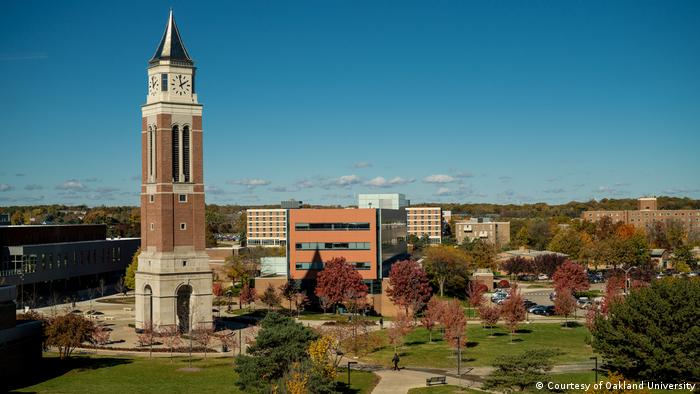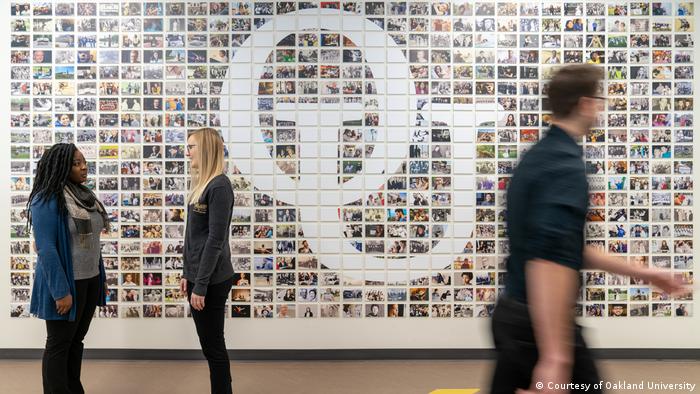US college enrollment another victim of COVID?
For a decade, US student enrollment numbers in undergraduate programs have been headed down. With wages up, ever more would-be students seem attracted to paychecks rather than higher education.

Many colleges hoped students were just taking a year off because of COVID-19 and would return
Higher education has long been seen as the way to get a good job. Many job descriptions explicitly list a college degree as a prerequisite. Despite this, student enrollment in undergraduate programs has been gradually falling for the past decade, with the coronavirus pandemic giving it an extra push downward.
Since fall 2019, overall undergraduate enrollment at US colleges fell by 6.6% to just a little over 14.4 million full- and part-time students, according to the nonprofit National Student Clearing House Research Center. That equates to more than 1 million fewer students than two years ago.
Public colleges and universities offering four-year bachelor's programs and private for-profit schools have all experienced a decline in student numbers. Community colleges, which mainly offer two-year associate programs and often serve low-income students, students of color and older students, have been hit the hardest, with a 13% drop in enrollment.
But if schooling is so important, why are fewer students signing up? And what does this mean for their future and the economy?

Empty campuses can mean summer break, more online classes or fewer students
Case in point: Michigan
In Michigan, student enrollment for two- and four-year programs was down in nearly every corner of the state compared with 2019. In the past two years, the state sent 17,500 fewer high school graduates to college than would have been expected, according to research just released by Bridge Michigan, a nonprofit news organization.
Oakland University, an hour north of Detroit, had been faring well before the pandemic. It hit an enrollment high in 2016 and welcomed its second-largest freshman classes in history in the fall of 2018 and 2019, according to Dawn Aubry, vice president for enrollment management.
After 2019, enrollment fell by 2,100 students: today the school has just over 12,500 undergraduates. A slight decrease in retention rates added to the problem as students dropped out. This hit nearly every demographic group. "However, some groups were impacted even more than others. Underrepresented minority students, in particular, had far lower retention rates than in past years," Aubry told DW.
Another problem was an increase in the number of students who were accepted to attend in fall 2021 but chose not to attend college at all. This jumped 48% compared with the previous year. "Though some of these students may choose to join us in a later semester, our challenge is now reconnecting with this population of students to help explain the value of higher education and the benefit of earning a bachelor's degree," said Aubry.

Dawn Aubry is vice president for enrollment management at Oakland University
Long-term impact on the economy
Convincing prospective students shouldn't be too difficult on paper. A study released in October by Georgetown University concluded that workers with a bachelor's degree earn a median of $2.8 million during their career. This is 75% more than if they only had a high school diploma.
Besides greater earning potential, data has shown that a degree opens the door to more career opportunities and higher job satisfaction. People with more education are less likely to lose their job, and if they do, are more likely to find a new one.
"While college isn't the right path for everyone, it does provide one of the best options for upward economic mobility. If fewer people are attending, that could have huge impacts on family financial security and the economy down the road," said Sarah Sattelmeyer, project director of education, opportunity and mobility with the higher education program at New America, a Washington D.C.-based think tank.
Putting off college, for now at least
Still, there are many reasons why higher education has suffered in the US. Due to a lower birth rate, the overall number of high school graduates is not growing and is flat, or even declining in places. That means the pipeline of new students is shrinking.
At the same time, tuition costs are going up, putting college out of reach for those unable to get grants or unwilling to take on student loans.

Some would-be students needed to work to support families or had caregiving obligations and avoided school
The COVID pandemic has played a unique role, keeping recruiters away from high schools and students from visiting campuses. During lockdowns, many students were not interested in paying full tuition to sit at home and follow online-only classes. Travel restrictions locked out a good deal of foreign students altogether.
The pandemic also forced many families into precarious financial circumstances. For these prospective students, more school was no longer an option. They had to work to pay their bills.
Jobs instead of college
Others in less of a tight financial spot have been tempted by a labor market where employers are fighting over workers by paying more. These workers see no need for a degree when they are earning more than ever, especially for hospitality and low-skilled jobs.
"Historically, college enrollment has been countercyclical, especially at community colleges. When the economy contracts, more people return to or enroll in school. When the economy expands, many often return to work," Sattelmeyer told DW.
But this cycle has not played out the same during the pandemic, as many would-be students never enrolled or left programs altogether.
"While enrollment has trended downward in recent years for a host of reasons, the pandemic accelerated this trend, especially for undergraduates," Sattelmeyer said. Limited resources and events have upended lives and not everyone has access to fast internet connections or the technology necessary for schooling.

Before COVID-19 college sports like basketball were a great way to create a connection to students
The problem is much bigger than just enrollment numbers though. Local and state governments have helped colleges during the pandemic, but this new situation underscores the need for longer-term investment in programs that actually facilitate graduation, argues Sattelmeyer.
Getting students back in classrooms
Yet, before structural changes can happen, schools are trying to get students back as quickly as possible. To do this, colleges are offering scholarship programs, trying out special recruiting campaigns and going after students who have dropped out.
At Oakland University, the admissions team is working to explain why there has never been a better time to invest in the future by pursuing a degree. They are committed to helping keep the students they have and retrieve the ones who have stopped attending with a program called Golden Grizzlies Graduate.
The new initiative is flexible and meant to help students return to or stay at the school. It is a holistic approach "complete with financial grants and specialized resources" to allow undergraduate students to earn their bachelor's degrees, said Aubry.
For the school, more students cannot come soon enough. The same can be said for Michigan, because — like the rest of the US — it is suffering from a lack of workers with specialized skills. More than ever, future economic success will depend on IT specialists, data analysts, software developers, cyber security experts and engineers.
No comments:
Post a Comment